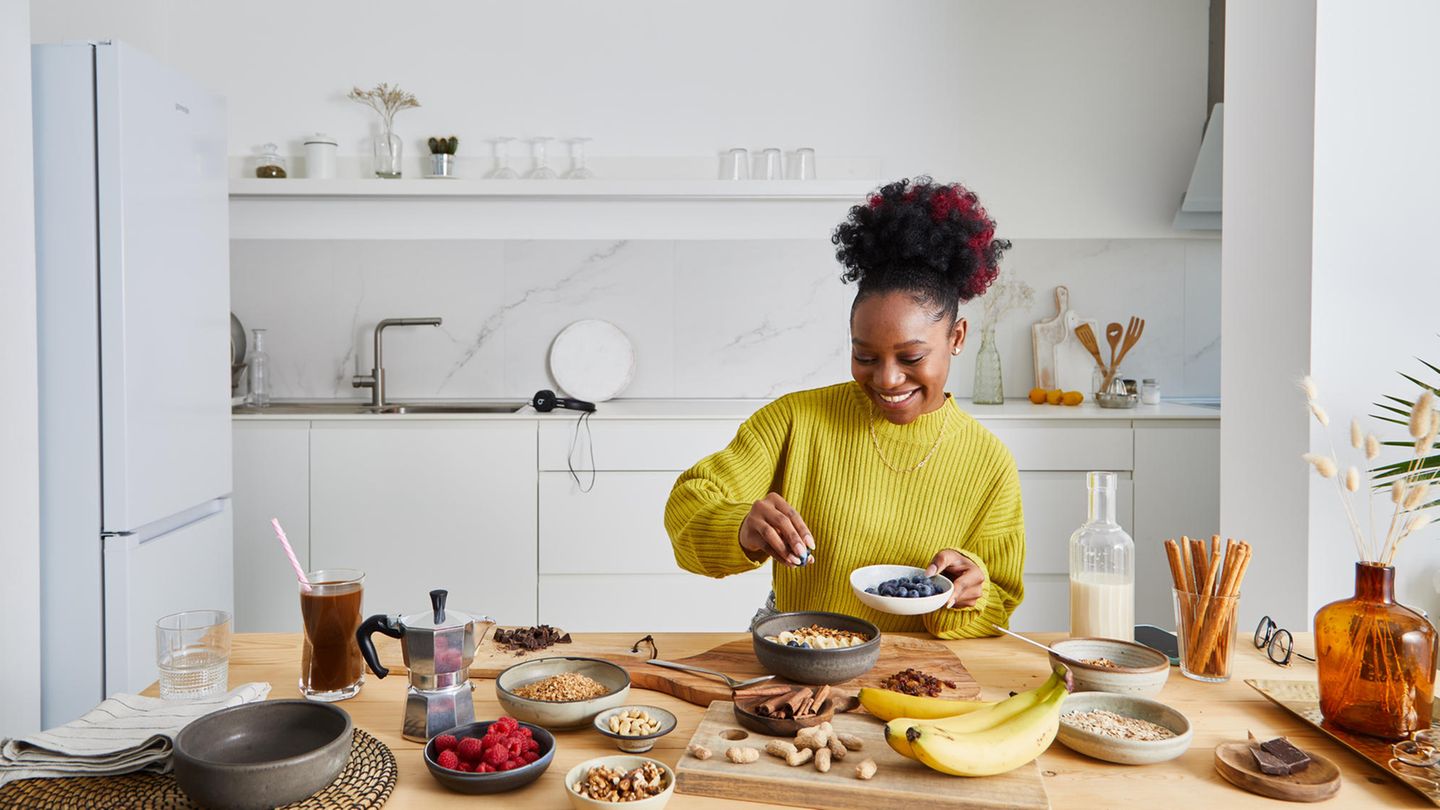Helpful tips
Sugar -free nutrition: Expert explains what to look out for
Copy the current link
Add to the memorial list
A sugar -free diet is good for the body – but it is not easy to adhere to. Nutrition expert Maja Biel gives that star Helpful and above all implementable tips.
The fact that sugar does not necessarily do well with the body is nothing new. Above all, the added, also known as free sugar, means that the blood sugar level rises quickly, there is cravings and the weight increases with regular consumption. A sugar -free diet should avoid these negative effects. Read below how you can do without whether you really have to avoid any kind of sugar and what recipes you can cook.
What types of sugar are there?
In order to be able to eat sugar -free, it is important in the first step to know which types of sugar there are and which are dispensable. Nutritionist Maja Biel explains that star In addition: “Sugar means carbohydrates first. On the one hand, there is industrial sugar. Here the carbohydrates, i.e. the sugar, isolated, industrially, from sugar beets or sugar cane, for example. This type of sugar is the saccharosis.” If one speaks of sugar, this white household sugar is usually meant.
In addition, there are even more industrially produced isolated species, according to the expert. At a glance are: glucose, fructose, sucrose. But also, for example, honey, syrup, fruit juice concentrates and other things, if there is talk of free sugar – i.e. the sugar that should be omitted in sugar -free diet.
“And then there is sugar that naturally occurs in food. For example, the fructose in the apple. The difference is always that the sugar is in a network of other nutrients: vitamin B, folic acid, potassium, for example. Another example is the milk sugar, the lactose, which is also natural in milk. There are still protein, fat and other two types. Simply keeping it, always distinguishing: one of the natural sugar in natural foods, in conjunction with other nutrients, and then the isolated sugar, i.e. industrial sugar, so to speak. “
How should I do without sugar -free diet?
“The question of how sugar -free diet is interpreted. There are, for example, To the sugar -free diet or stories from some people in the environment. Most of the time, the white household sugar is meant, but also something like agave, corn extract, fructose syrup or everything that is added. Sometimes, however, it is only dispensed with the white sugar and this is replaced by honey or something else – which is then not so effective. “Sometimes it is also happy to be used on dates, which, however, also contain a lot of concentrated sugar.” I am not in favor of being very dogmatic and forbidding it all. But you should have a bit in mind: that’s sugar too. “
Instead of simply replacing the white sugar with other types of sugar, Maja Biel recommends something else in a sugar -free diet: “I would definitely recommend fruit, because there are also many other important nutrients in it: vitamins, minerals, etc. Fruit also has a more natural, lighter sweetness.” This allows you to gradually lower the level of the sweetness.
It is also important if you want to adhere to a sugar -free diet, also to think of products that contain a lot of sugar, although they may not taste so sweet. “Something like ketchup or frozen pizza. But also fruit yogurt, muesli bar, muesli, bought smoothies. Then you may think: ‘Oh, is fruit, is healthy’. But fresh fruit is the better choice.”
What is the positive effect of the (most widespread) waiver?
Those who largely do without sugar will feel some advantages. The expert also knows that: “Anyone who has done a long time on sugar for a long time will know that the sweet level will be reduced and sweets taste much sweeter afterwards than usual. Weight loss can also go hand in hand with the new diet. “Cravings can become less. If, for example, you eat a chocolate bar over the afternoon, the blood sugar goes up and down and that keeps craving more and again.
Positive effects may also be that you can concentrate better and have a more stable energy level. “You usually feel more balanced, more satisfied. Depending on how much sugar you have eaten before, there is a positive impact on the intestinal microbioma, the bacteria that have the whole intestinal flora.” The risk of diabetes can also be reduced. Just like the risk of getting caries. “But I have to say that everything is also possible with sugar in the diet.” It usually depends on the amount of consumption.
For orientation: The World Health Organization WHO recommends that adults should have a maximum of 25 grams of sugar added per day. Everything that lies above is therefore harmful to health. The excessive enjoyment of sugar is, for example, the main driver for the development of the particularly unhealthy belly fat. A most extensive waiver can therefore only be good.
Can a sugar -free diet be problematic?
Fooding completely sugar -free has many positive effects. However, the changeover is usually not entirely unproblematic. Biel explains: “There may have been a habituation effect. The body, the brain, especially the psyche gets used to the sugar. If you suddenly do without, there can be small withdrawal symptoms, i.e. a change of conversion in which you really have the feeling: ‘I don’t take it, I need something sweet now.’ At some point away. However, it could take a few days for the body to get used to it. “Some people even get a headache. It’s like a small sugar withdrawal. But the good news is: it is getting better and better.”
Recipe
If you want to test a sugar -free diet in concrete terms, you should fall back on long filling foods or recipes. The expert has the following tips: “The day best starts with a filling breakfast. Here I keep hearing that, for example, porridge just does not hold up for long. A filling meal should always contain carbohydrates, protein and fats. And added a bit of fruit or yogurt, it becomes round. Or nuts, they also have protein. “Also the addition of for example, that is available from brands like NU3, can help to stay full and add a certain sweetness.
At lunchtime there could be a bowl with rice, but also again protein -containing foods, for example chickpeas, fish, tofu, vegetables. “Vegetables always have a lot of volume, but few calories, so it also fills the stomach. It’s a perfect combination.” Most of the time, however, there is still a snack. “Otherwise it is no wonder if you come home starved to run home to run to the fridge or open the candy drawer.” A good snack could then be a handful be a piece of fruit. “Even with snacks, you should make sure that it is not only made of carbohydrates. A few blueberries and two pieces For example. “In the evening it can be a slice of bread with two fried eggs.” Perhaps salad again if you tolerate it well. Or steamed vegetables. And if you may have the desire for something sweet, a yogurt with a piece of fruit would be a good choice. “
More tips for a sugar -free diet
- A change overnight is usually unrealistic. A It can help to recognize what your own diet actually looks like and to determine what you might want to change. Every cola and piece of chocolate should be recorded. In addition, holding out can help find out why you have just eaten a bar of chocolate, says Maja Biel: “Is that now because I’m completely starved? Was it emotionally eating? Because I’m so stressed? Is that because I feel alone on the sofa and feel lonely in the evening? Chocolate?”
- Not be too drastic and forbid everything for yourself. Sugar should be eaten in moderation and there may be exceptions, such as a birthday. Otherwise the waiver can restrict something socially. In addition, complete sugar breaks are also helpful for the extensive waiver in order to regulate the sweet level again.
- Individual approaches are helpful: If you do not endure it to have a bar of chocolate in your closet, the next time you shop, you can deliberately only use the chocolate bar, which can then also be eaten completely at home.
Used sources: (DDG) / Who
*This article contains so-called affiliate links to products in online shops. If a user clicks on it and buys something, the publisher receives a commission from the dealer, not from the manufacturer. Of course, where and when you buy a product is up to you.
Source: Stern
I’m Caroline, a journalist and author for 24 Hours Worlds. I specialize in health-related news and stories, bringing real-world impact to readers across the globe. With my experience in journalism and writing in both print and online formats, I strive to provide reliable information that resonates with audiences from all walks of life.




